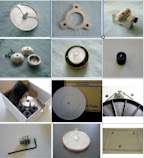
A record being played on a famous vintage Thorens TD160 turntable
LP players or turntables are gaining more and more enthusiasts these days as many are discovering or re-discovering the wonderful sounds of vinyl (analogue) and naturally they are looking for good turntables to play their favorite LPs’.
Basic components of turntables are:
a) motor drive and plinth (main body)
b) platter with or without sub-platter
c) tonearm and cartridge
This is how a turntable works: The AC or DC motor drives the platter which holds the LP through a rubber or modern-day acrylic mate, at the required speed, e.g. 33.3rpm or 45rpm, and the tonearm with the cartridge tracks the LP(record) grooves to produce electrical signals which are then fed to the input of an amplifier to produce the music/song.
Turntables can be broadly classified into three types:
1. Idler-drive
2. Belt-drive
3. Direct drive
Most of the early turntables are idler-driven and as the name implies, a rubber-rimmed idler is used to drive the turntable platter at the required speeds. Some examples of idler driven turntables are Garrard 301, Lenco L75 and Thorens 124 and many ubiquitous Japanese brands like Pioneer, Sansui, JVC, Kenwood, Akai etc.
Most of the later turntables are either belt-drive, which use a rubber belt to drive the platter/sub-platter, or direct-drive which turn the platter directly without a belt or idler.
Some examples of belt-driven turntables are Thorens 150/160 , Lenco L82, Rega Planar 3, Pioneer P12D, Sansui FR-D25, Luxman PD-210, Pro-ject 1.2 etc
Some examples of direct-driven turntables are Technics 1200MKII ,Luxman 277/282 , ADC 1700, Akai AP-D30 , Denon DP-30L etc




































